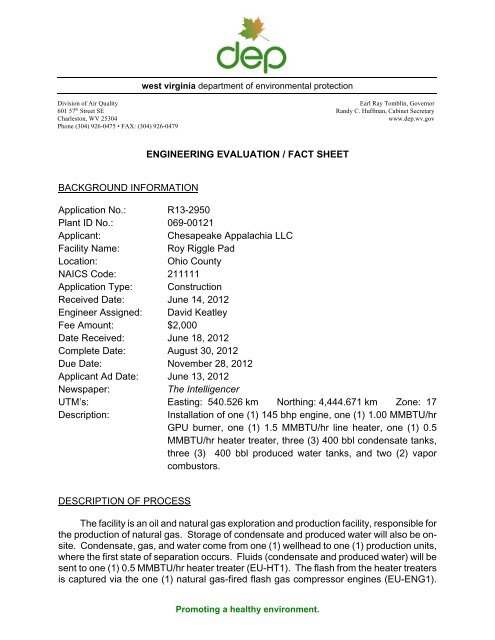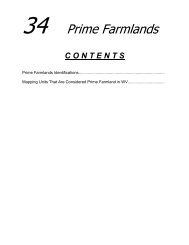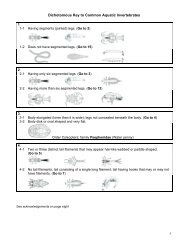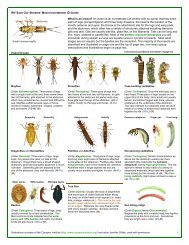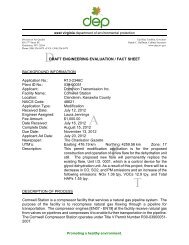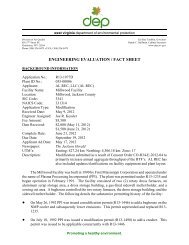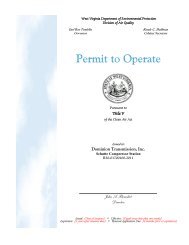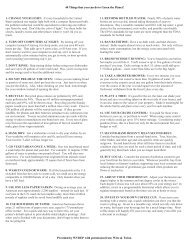Z:\Jennifer\Jennifer\R13 Permits\Chesapeake- Roy Riggle- 2950 ...
Z:\Jennifer\Jennifer\R13 Permits\Chesapeake- Roy Riggle- 2950 ...
Z:\Jennifer\Jennifer\R13 Permits\Chesapeake- Roy Riggle- 2950 ...
You also want an ePaper? Increase the reach of your titles
YUMPU automatically turns print PDFs into web optimized ePapers that Google loves.
Division of Air Quality<br />
601 57 th Street SE<br />
Charleston, WV 25304<br />
Phone (304) 926-0475 • FAX: (304) 926-0479<br />
BACKGROUND INFORMATION<br />
ENGINEERING EVALUATION / FACT SHEET<br />
Application No.: R13-<strong>2950</strong><br />
Plant ID No.: 069-00121<br />
Applicant: Chesapeake Appalachia LLC<br />
Facility Name: <strong>Roy</strong> <strong>Riggle</strong> Pad<br />
Location: Ohio County<br />
NAICS Code: 211111<br />
Application Type: Construction<br />
Received Date: June 14, 2012<br />
Engineer Assigned: David Keatley<br />
Fee Amount: $2,000<br />
Date Received: June 18, 2012<br />
Complete Date: August 30, 2012<br />
Due Date: November 28, 2012<br />
Applicant Ad Date: June 13, 2012<br />
Newspaper: The Intelligencer<br />
UTM’s: Easting: 540.526 km Northing: 4,444.671 km Zone: 17<br />
Description: Installation of one (1) 145 bhp engine, one (1) 1.00 MMBTU/hr<br />
GPU burner, one (1) 1.5 MMBTU/hr line heater, one (1) 0.5<br />
MMBTU/hr heater treater, three (3) 400 bbl condensate tanks,<br />
three (3) 400 bbl produced water tanks, and two (2) vapor<br />
combustors.<br />
DESCRIPTION OF PROCESS<br />
west virginia department of environmental protection<br />
The facility is an oil and natural gas exploration and production facility, responsible for<br />
the production of natural gas. Storage of condensate and produced water will also be onsite.<br />
Condensate, gas, and water come from one (1) wellhead to one (1) production units,<br />
where the first state of separation occurs. Fluids (condensate and produced water) will be<br />
sent to one (1) 0.5 MMBTU/hr heater treater (EU-HT1). The flash from the heater treaters<br />
is captured via the one (1) natural gas-fired flash gas compressor engines (EU-ENG1).<br />
Promoting a healthy environment.<br />
Earl Ray Tomblin, Governor<br />
Randy C. Huffman, Cabinet Secretary<br />
www.dep.wv.gov
The natural gas fired compressor engine is a four-stroke rich-burn Caterpillar G3306 NA<br />
equipped with a NSCR catalyst which will reduce the emissions of NOx, CO, and VOCs.<br />
Produced water from the heater treaters flows into the produced water storage tanks EU-<br />
TANKS-PW. There are three (3) 12,400 gallon water storage tanks. Condensate flows into<br />
the two low-pressure towers. Flash gases from the low-pressure tower(s) are routed via<br />
hard-piping to the two (2) vapor combustors to be burned with at least 98% combustion<br />
efficiency. Condensate flows to the condensate storage tanks EP-TANKS-COND. There<br />
are three (3) 12,400 gallon condensate storage tanks. The natural gas stream will exit the<br />
facility for transmission via pipeline. Condensate and produced water are transported<br />
offsite via truck. Loading emissions will be controlled with vapor return, which has a 70%<br />
capture efficiency, routed to the he vapor combustors EU-PILOTS for at least 98%<br />
destruction efficiency. Working, breathing, and flashing vapors from the condensate and<br />
produced water storage tanks will be routed to the vapor combustors to be burned with at<br />
least 98% combustion efficiency. Each vapor combustor has a natural gas-fired pilot EU-<br />
PILOTS to ensure a constant flame for combustion. A line heater (EU-LH1) may be used<br />
during the beginning phase of facility operations.<br />
SITE INSPECTION<br />
From WV 88 (Chatham Street) in West Liberty, WV turn right onto Main Street to stay<br />
on WV 88 for 0.8 miles. Take the second right onto CR 53 (W Liberty Patomac Road) and<br />
go 1.4 miles. Stay to the right to continue on CR 53 (W Liberty Patomac Road) for 0.2<br />
miles and turn right onto CR 53/1 for 0.2 miles. Turn right onto CR 53 (W Liberty Patomac<br />
Road) and drive 2.2 miles to CR 53/4 (Castleman Run Road). After approximately 300 feet<br />
the facility's access road will be on the right.<br />
Steven J. Sobutka from the DAQ's Compliance and Enforcement performed a site visit on<br />
August 24, 2012. The well pad sits atop a hill and the nearest residence is at least 1/4 mile<br />
away.<br />
ESTIMATE OF EMISSIONS BY REVIEWING ENGINEER<br />
The Caterpillar Engine emission factors are from the catalyst manufacturer (CM), the<br />
engine manufacturer (EM), and AP-42. Emission factors from the EM in g/bhp-hr are:<br />
VOC, 0.49; and formaldehyde, 0.27. Emissions factors for the CM in g/bhp-hr are: NO x,<br />
1.0; and CO, 2.0. The emission factors from AP-42 in lb/MMBTU are: PM and PM 10,<br />
0.00999; and SO 2, 0.000588.<br />
The GPU burner(s), Heater Treater(s), and Line Heater(s) use emission factors from AP-<br />
42. The emission factors in lb/MMscf are: NO x, 100; CO, 84; SO 2, 0.6; PM, 7.6; and VOC,<br />
5.5.<br />
Emissions for EP-TANKS-COND working and breathing emissions were estimated using<br />
TANKS 4.0.9d and the flash emissions were estimated using ProMax. The Vapor<br />
Page 2 of 13<br />
Fact Sheet R13-<strong>2950</strong><br />
Chesapeake Appalchia, LLC<br />
<strong>Roy</strong> <strong>Riggle</strong> Pad
Combustors are considered to have a 98% efficiency.<br />
The emissions from the other tanks were considered negligible due to the combination of<br />
small tank size and low vapor pressure of tank contents.<br />
The following table lists the estimated emissions:<br />
Source ID Emission Source Pollutant Maximum Hourly Maximum Annual<br />
Emissions (lb/hr) Emissions (tpy)<br />
NOx 0.32 1.40<br />
EU- Flash Gas Compressor CO 0.64 2.80<br />
MC4248<br />
Engine VOC 0.16 0.67<br />
Caterpillar 3306 NA PM 0.02 0.09<br />
PM10 0.02 0.09<br />
Formaldehyde 0.09 0.38<br />
CO2e 155.18 679.70<br />
NOx 0.11 0.48<br />
EU-GPU1 GPU Burner 1 CO 0.09 0.39<br />
1.00 MMBTU/hr VOC 0.01 0.03<br />
PM 0.01 0.04<br />
PM10 0.01 0.04<br />
CO2e 117.00 512.48<br />
NOx 0.17 0.74<br />
EU-LH1 Line Heater 1 CO 0.14 0.61<br />
1.5 MMBTU/hr VOC 0.01 0.04<br />
PM 0.01 0.06<br />
PM10 0.01 0.06<br />
CO2e 175.51 767.96<br />
EU-HT1 Heater Treater 1<br />
0.5 MMBTU/hr<br />
NOx CO<br />
0.06<br />
0.05<br />
0.26<br />
0.22<br />
VOC
EP-<br />
LOAD-PW Produced Water Truck<br />
Loading<br />
VOC 0.01 0.06<br />
CO 2e 0.16 0.71<br />
NOx 4.14 18.13<br />
APC- Two (2) Vapor Combustors CO 8.27 36.22<br />
Combustors 15 MMBTU/hr VOC 5.09 22.29<br />
PM 0.09 0.39<br />
PM10 0.09 0.39<br />
Benzene
The following table indicates the control device efficiencies that are required for this facility:<br />
Emission Unit Pollutant Control Device Control<br />
Efficiency<br />
EU-MC4207 Nitrogen Oxides Non Selective Catalytic 92.58 %<br />
Compressor Engine Carbon Monoxide Reduction (NSCR) 85.15 %<br />
EU-TANKS-COND, Volatile Organic Compounds Vapor Combustor 98.00 %<br />
EU-TANKS-PW<br />
Storage Tanks<br />
Total HAPs 98.00 %<br />
EU-LOAD-COND, EU- Volatile Organic Compounds Vapor Return/ 70.00 %<br />
LOAD-PW<br />
Loadout Racks<br />
Combustion<br />
REGULATORY APPLICABILITY<br />
Unless otherwise stated WVDEP DAQ did not determine whether the permittee is subject to an area<br />
source air toxics standard requiring Generally Achievable Control Technology<br />
(GACT) promulgated after January 1, 2007 pursuant to 40 CFR 63, including the area source air<br />
toxics provisions of 40 CFR 63, Subpart ZZZZ.<br />
The following rules apply to the facility:<br />
45CSR2 (Particulate Air Pollution from Combustion of Fuel in Indirect Heat Exchangers)<br />
The purpose of 45CSR2 (Particulate Air Pollution from Combustion of Fuel in Indirect Heat<br />
Exchangers) is to establish emission limitations for smoke and particulate matter which are<br />
discharged from fuel burning units.<br />
45CSR2 states that any fuel burning unit that has a heat input under ten (10) million B.T.U.'s<br />
per hour is exempt from sections 4 (weight emission standard), 5 (control of fugitive<br />
particulate matter), 6 (registration), 8 (testing, monitoring, recordkeeping, reporting) and 9<br />
(startups, shutdowns, malfunctions). However, failure to attain acceptable air quality in parts<br />
of some urban areas may require the mandatory control of these sources at a later date.<br />
The heat input of all of the proposed fuel burning units (EP-GPU1, EP-HT1, and EP-LH1)<br />
are below 10 MMBTU/hr. Therefore, these units are exempt from the aforementioned<br />
sections of 45CSR2. However, CHK would be subject to the opacity requirements in<br />
45CSR2, which is 10% opacity based on a six minute block average.<br />
45CSR4 (To Prevent and Control the Discharge of Air Pollutants into the Open Air which Causes<br />
or Contributes to an Objectionable Odor or Odors)<br />
This facility shall not cause the discharge of air pollutants which cause or contribute to an<br />
objectionable odor at any location occupied by the public. 45CSR4 states that an<br />
Page 5 of 13<br />
Fact Sheet R13-<strong>2950</strong><br />
Chesapeake Appalchia, LLC<br />
<strong>Roy</strong> <strong>Riggle</strong> Pad
objectionable odor is an odor that is deemed objectionable when in the opinion of a duly<br />
authorized representative of the Air Pollution Control Commission (Division of Air Quality),<br />
based upon their investigations and complaints, such odor is objectionable.<br />
45CSR6 (To Prevent and Control Air Pollution from the Combustion of Refuse)<br />
The purpose of this rule is to prevent and control air pollution from combustion of refuse.<br />
CHK has two (2) vapor combustors at the facility. The vapor combustors are subject to<br />
section 4, emission standards for incinerators. The vapor combustors have an allowable<br />
emission rate of 1.01 pounds of particulate matter per hour. Each vapor combustor has an<br />
emission limit of 0.05 pounds of particulate matter per hour. Therefore, the facility’s vapor<br />
combustors should demonstrate compliance with this section. The facility will demonstrate<br />
compliance by maintaining records of the amount of natural gas consumed by the vapor<br />
combustors and the hours of operation. The facility will also monitor the flame of the vapor<br />
combustors and record any malfunctions that may cause no flame to be present during<br />
operation. The opacity limit for the is flare is 20%.<br />
45CSR10 (To Prevent and Control Air Pollution from the Emissions of Sulfur Oxides)<br />
45CSR10 states that any fuel burning unit that has a heat input under ten (10) million<br />
B.T.U.'s per hour is exempt from sections 3 (weight emission standard), 6 (registration), 7<br />
(permits), and 8 (testing, monitoring, recordkeeping, reporting). However, failure to attain<br />
acceptable air quality in parts of some urban areas may require the mandatory control of<br />
these sources at a later date.<br />
The heat input of all of the proposed fuel burning units (EP-GPU1, EP-LH1, and EP-HT1)<br />
are below 10 MMBTU/hr. Therefore, these units are exempt from the aforementioned<br />
sections of 45CSR10.<br />
45CSR13 (Permits for Construction, Modification, Relocation and Operation of Stationary Sources<br />
of Air Pollutants, Notification Requirements, Administrative Updates, Temporary Permits, General<br />
Permits, and Procedures for Evaluation)<br />
45CSR13 applies to this source due to the fact that the changes proposed under this permitting<br />
action results in an emissions increase above permitting thresholds. Therefore, CHK is<br />
required to submit a construction application. CHK has published the required Class I legal<br />
advertisement notifying the public of their permit application, and paid the appropriate<br />
application fee (construction).<br />
45CSR22 (Air Quality Management Fee Program)<br />
This facility is a minor source and not subject to 45CSR30. CHK is required to keep their<br />
Certificate to Operate current. CHK also paid a 1,000 NSPS fee.<br />
Page 6 of 13<br />
Fact Sheet R13-<strong>2950</strong><br />
Chesapeake Appalchia, LLC<br />
<strong>Roy</strong> <strong>Riggle</strong> Pad
40CFR60 Subpart JJJJ (Standards of Performance for Stationary Spark Ignition Internal<br />
Combustion Engines (SI ICE))<br />
40CFR60.4230 states that a source that commenced construction after June 12, 2006 whose<br />
SI ICE was less than 500 hp and was manufactured on or after July 1, 2008 is subject to this<br />
rule. CHK has proposed to install one (1) 145 HP SI ICE. Since the SI ICE that CHK will<br />
install was manufactured on January 3, 2012, CHK is subject to this rule.<br />
40CFR60 Subpart OOOO (Standards of Performance for Crude Oil and Natural Gas Production,<br />
Transmission and Distribution)<br />
EPA issued it new source performance standards (NSPS) and air toxics rules for the oil and<br />
gas sector on April 17, 2012. 40CFR60 Subpart OOOO establishes emission standards and<br />
compliance schedules for the control of volatile organic compounds (VOC) and sulfur<br />
dioxide (SO 2) emissions from affected facilities that commence construction, modification<br />
or reconstruction after August 23, 2011. The following affected sources which commence<br />
construction, modification or reconstruction after August 23, 2011 are subject to the<br />
applicable provisions of this subpart:<br />
a. Each gas well affected facility, which is a single natural gas well.<br />
The gas wells that currently exist at the <strong>Roy</strong> <strong>Riggle</strong> Pad were drilled principally for<br />
the production of natural gas and were done so after August 23, 2011. Therefore,<br />
these wells would be considered affected facilities under this subpart.<br />
b. Each centrifugal compressor affected facility, which is a single centrifugal<br />
compressor using wet seals that is located between the wellhead and the point of<br />
custody transfer to the natural gas transmission and storage segment. For the<br />
purposes of this subpart, your centrifugal compressor is considered to have<br />
commenced construction on the date the compressor is installed (excluding<br />
relocation) at the facility. A centrifugal compressor located at a well site, or an<br />
adjacent well site and servicing more than one well site, is not an affected facility<br />
under this subpart.<br />
There are no centrifugal compressors at the <strong>Roy</strong> <strong>Riggle</strong> Pad. Therefore, this section<br />
would not apply.<br />
c. Each reciprocating compressor affected facility, which is a single reciprocating<br />
compressor located between the wellhead and the point of custody transfer to the<br />
natural gas transmission and storage segment. For the purposes of this subpart, your<br />
reciprocating compressor is considered to have commenced construction on the date<br />
the compressor is installed (excluding relocation) at the facility. A reciprocating<br />
compressor located at a well site, or an adjacent well site and servicing more than<br />
one well site, is not an affected facility under this subpart.<br />
Page 7 of 13<br />
Fact Sheet R13-<strong>2950</strong><br />
Chesapeake Appalchia, LLC<br />
<strong>Roy</strong> <strong>Riggle</strong> Pad
There is one (1) 145 hp reciprocating internal combustion engines located at the<br />
<strong>Roy</strong> <strong>Riggle</strong> Pad. This engine was delivered on April 1, 2012 which is after to the<br />
effective date of this rule. However, the rule specifically states that any<br />
reciprocating compressor located at a well site is not an affected facility under this<br />
subpart. Therefore, this section would not apply.<br />
d. 1. Each pneumatic controller affected facility, which is a single continuous bleed<br />
natural gas-driven pneumatic controller operating at a natural gas bleed rate greater<br />
than 6 scfh which commenced construction after August 23, 2011, and is located<br />
between the wellhead and the point of custody transfer to the natural gas<br />
transmission and storage segment and not located at a natural gas processing plant.<br />
2. Each pneumatic controller affected facility, which is a single continuous bleed<br />
natural gas-driven pneumatic controller which commenced construction after August<br />
23, 2011, and is located at a natural gas processing plant.<br />
There are no pneumatic controllers at the <strong>Roy</strong> <strong>Riggle</strong> Pad. Therefore, this section<br />
would not apply.<br />
e. Each storage vessel affected facility, which is a single storage vessel, located in the<br />
oil and natural gas production segment, natural gas processing segment or natural gas<br />
transmission and storage segment.<br />
40CFR60 Subpart OOOO defines a storage vessel as a unit that is constructed<br />
primarily of nonearthen materials (such as wood, concrete, steel, fiberglass, or<br />
plastic) which provides structural support and is designed to contain an accumulation<br />
of liquids or other materials. The following are not considered storage vessels:<br />
1. Vessels that are skid-mounted or permanently attached to something that is<br />
mobile (such as trucks, railcars, barges or ships), and are intended to be located at a<br />
site for less than 180 consecutive days. If the source does not keep or are not able to<br />
produce records, as required by §60.5420(c)(5)(iv), showing that the vessel has been<br />
located at a site for less than 180 consecutive days, the vessel described herein is<br />
considered to be a storage vessel since the original vessel was first located at the site.<br />
2. Process vessels such as surge control vessels, bottoms receivers or knockout<br />
vessels.<br />
3. Pressure vessels designed to operate in excess of 204.9 kilopascals and without<br />
emissions to the atmosphere.<br />
This rule requires that the permittee determine the VOC emission rate for each<br />
storage vessel affected facility utilizing a generally accepted model or calculation<br />
methodology within 30 days of startup, and minimize emissions to the extent<br />
practicable during the 30 day period using good engineering practices. For each<br />
Page 8 of 13<br />
Fact Sheet R13-<strong>2950</strong><br />
Chesapeake Appalchia, LLC<br />
<strong>Roy</strong> <strong>Riggle</strong> Pad
storage vessel affected facility that emits more than 6 tpy of VOC, the permittee must<br />
reduce VOC emissions by 95% or greater within 60 days of startup.<br />
All three (3) EP-TANKS-COND tanks located at the <strong>Roy</strong> <strong>Riggle</strong> Pad emit more than<br />
6 tpy of VOC (16.58 tpy each). Therefore, CHK would be required by this section<br />
to reduce VOC emissions by 95%. To meet this requirements CHK has proposed to<br />
install vapor combustors to capture 98% of the VOC emissions from the storage<br />
tanks.<br />
f. The group of all equipment, except compressors, within a process unit is an<br />
affected facility.<br />
1. Addition or replacement of equipment for the purpose of process improvement<br />
that is accomplished without a capital expenditure shall not by itself be considered<br />
a modification under this subpart.<br />
2. Equipment associated with a compressor station, dehydration unit, sweetening<br />
unit, underground storage vessel, field gas gathering system, or liquefied natural gas<br />
unit is covered by §§60.5400, 60.5401, 60.5402, 60.5421 and 60.5422 of this subpart<br />
if it is located at an onshore natural gas processing plant. Equipment not located at<br />
the onshore natural gas processing plant site is exempt from the provisions of<br />
§§60.5400, 60.5401, 60.5402, 60.5421 and 60.5422 of this subpart.<br />
3. The equipment within a process unit of an affected facility located at onshore<br />
natural gas processing plants and described in paragraph (f) of this section are<br />
exempt from this subpart if they are subject to and controlled according to subparts<br />
VVa, GGG or GGGa of this part.<br />
The <strong>Roy</strong> <strong>Riggle</strong> Pad is not a natural gas processing plant. Therefore, LDAR for<br />
onshore natural gas processing plants would not apply.<br />
g. Sweetening units located at onshore natural gas processing plants that process<br />
natural gas produced from either onshore or offshore wells.<br />
1. Each sweetening unit that processes natural gas is an affected facility; and<br />
2. Each sweetening unit that processes natural gas followed by a sulfur recovery unit<br />
is an affected facility.<br />
3. Facilities that have a design capacity less than 2 long tons per day (LT/D) of<br />
hydrogen sulfide (H 2S) in the acid gas (expressed as sulfur) are required to comply<br />
with recordkeeping and reporting requirements specified in §60.5423(c) but are not<br />
required to comply with §§60.5405 through 60.5407 and paragraphs 60.5410(g) and<br />
60.5415(g) of this subpart.<br />
Page 9 of 13<br />
Fact Sheet R13-<strong>2950</strong><br />
Chesapeake Appalchia, LLC<br />
<strong>Roy</strong> <strong>Riggle</strong> Pad
4. Sweetening facilities producing acid gas that is completely reinjected into oil-orgas-bearing<br />
geologic strata or that is otherwise not released to the atmosphere are not<br />
subject to §§60.5405 through 60.5407, 60.5410(g), 60.5415(g), and 60.5423 of this<br />
subpart.<br />
There are no sweetening units at the <strong>Roy</strong> <strong>Riggle</strong> Pad. Therefore, this section would<br />
not apply.<br />
The following rules and regulations do not apply to the facility:<br />
40CFR60 Subpart 60.18 (General Control Device and Work Practice Requirements)<br />
40CFR60 Subpart 60.18 contains requirements for control devices when they are used to<br />
comply with applicable subparts of 40CFR60 and 40CFR61. The vapor combustor that<br />
CHK has proposed is not used to comply with one of these rules. The purpose of the vapor<br />
combustor is to control emissions from the tanks that are routed to it. However, these tanks<br />
are not subject to 40CFR60 Subpart Kb due to their size. In addition 40CFR60.18 refers to<br />
flares but makes no mention of vapor combustors, which are essentially enclosed combustion<br />
devices. Therefore, CHK is not subject to this standard.<br />
40CFR60 Subpart Kb (Standards of Performance for VOC Liquid Storage Vessels)<br />
40CFR60 Subpart Kb does not apply to storage vessels with a capacity less than 75 cubic<br />
meters. The tanks that CHK has proposed to install are 63.60 cubic meters each. Therefore,<br />
CHK would not be subject to this regulation.<br />
40CFR60 Subpart KKK (Standards of Performance for Equipment Leaks of VOC from Onshore<br />
Natural Gas Processing Plants)<br />
40CFR60 Subpart KKK applies to onshore natural gas processing plants that commenced<br />
construction after January 20, 1984. The <strong>Roy</strong> <strong>Riggle</strong> Pad is not a natural gas processing<br />
plant, therefore, CHK would not be subject to this regulation.<br />
45CSR14 (Permits for Construction and Major Modification of Major Stationary Sources of Air<br />
Pollutants)<br />
45CSR19 (Permits for Construction and Major Modification of Major Stationary Sources of Air<br />
Pollution which Cause or Contribute to Nonattainment)<br />
The <strong>Roy</strong> <strong>Riggle</strong> Pad is located in Ohio County which is a non-attainment county for<br />
Particulate Matter 2.5. Because Ohio County is a non-attainment county, 45CSR19 does<br />
apply to this facility.<br />
As shown in the table below, CHK is not subject to 45CSR14 or 45CSR19 review.<br />
Page 10 of 13<br />
Fact Sheet R13-<strong>2950</strong><br />
Chesapeake Appalchia, LLC<br />
<strong>Roy</strong> <strong>Riggle</strong> Pad
Pollutant PSD (45CSR14)<br />
Threshold (tpy)<br />
NANSR (45CSR19)<br />
Threshold (tpy)<br />
Page 11 of 13<br />
PTE (tpy) 45CSR14 or<br />
45CSR19 Review<br />
Required?<br />
Carbon Monoxide 250 NA 40.28 No<br />
Nitrogen Oxides 250 100 21.10 No<br />
Sulfur Dioxide 250 100 0.01 No<br />
Particulate Matter 2.5 250 100 0.60 No<br />
Ozone (VOC) 250 NA 31.89 No<br />
Greenhouse Gas (CO 2e) 100,000 NA 17,670.92 No<br />
TOXICITY OF NON-CRITERIA REGULATED POLLUTANTS<br />
There will be small amounts of various non-criteria regulated pollutants emitted from the<br />
combustion of natural gas. However, due to the concentrations emitted, detailed toxicological<br />
information is not included in this evaluation.<br />
AIR QUALITY IMPACT ANALYSIS<br />
Based on the annual emission rates this facility will not be a major source as<br />
defined by 45CSR14, so air quality modeling was not performed.<br />
SOURCE AGGREGATION<br />
“Building, structure, facility, or installation” is defined as all the pollutant emitting activities<br />
which belong to the same industrial grouping, are located on one or more contiguous and adjacent<br />
properties, and are under the control of the same person.<br />
The <strong>Roy</strong> <strong>Riggle</strong> Pad is located in Ohio County and will be operated by CHK, who is partial<br />
owner and operator. Several different entities are involved in the production, gathering, and<br />
transmission of gas. The Operators are the parties who drill and operate the wells. The Shippers<br />
are the owners of the gas who may or may not be the same entity as the Operator. There are also<br />
parties who own and operate the gathering system pipelines and compression station, called<br />
Gatherers. In addition, there are parties that own and operate the gas processing plants.<br />
1. The <strong>Roy</strong> <strong>Riggle</strong> Pad will operate under SIC code 1311 (Crude Petroleum and Natural<br />
Gas Extraction). There are surrounding wells and compressor stations operated by CHK that<br />
share the same two-digit major SIC code of 13 for oil and gas exploration and production.<br />
Therefore the <strong>Roy</strong> <strong>Riggle</strong> Pad does share the same SIC code as the wells and surrounding<br />
compressor stations.<br />
2. “Contiguous or Adjacent” determinations are made on a case by case basis. These<br />
determinations are proximity based, and it is important to focus on this and whether or not it<br />
Fact Sheet R13-<strong>2950</strong><br />
Chesapeake Appalchia, LLC<br />
<strong>Roy</strong> <strong>Riggle</strong> Pad
meets the common sense notion of a plant. The terms “contiguous” or “adjacent” are not defined<br />
by USEPA. Contiguous has a dictionary definition of being in actual contact; touching along a<br />
boundary or at a point. Adjacent has a dictionary definition of not distant; nearby; having a<br />
common endpoint or border.<br />
The closest well to the <strong>Roy</strong> <strong>Riggle</strong> Pad is over one quarter (1/4) mile away. Operations<br />
separated by these distances do not meet the common sense notion of a plant. Therefore, the<br />
properties in question are not considered to be on contiguous or adjacent property.<br />
3. According to CHK, none of the wells in the area are under common control with the<br />
<strong>Roy</strong> <strong>Riggle</strong> Pad. The <strong>Roy</strong> <strong>Riggle</strong> Pad is operated by CHK but is owned and controlled by a<br />
group of non-affiliated companies. Through proprietary agreements, CHK’s operation of <strong>Roy</strong><br />
<strong>Riggle</strong> Pad is controlled by the system owners. The ownership and control of the wells in the<br />
area may be distinct for each well and is not necessarily known by CHK. The owners and<br />
operators of the wells each may take their gas in kind and consequently affect the operation of<br />
the wells in which they have an ownership interest. Furthermore, no well is dependent on the<br />
operation of <strong>Roy</strong> <strong>Riggle</strong> Pad to function, nor is the <strong>Roy</strong> <strong>Riggle</strong> Pad dependent on any specific<br />
well to operate. From this analysis, CHK is not under common control with other wells in the<br />
area.<br />
Because the facilities are not considered to be on contiguous or adjacent properties and are<br />
not fully under control of the same person, the emissions from the <strong>Roy</strong> <strong>Riggle</strong> Pad should not be<br />
aggregated with other facilities in determining major source or PSD status.<br />
MONI TORI NG OF OPERATI ONS<br />
CHK will be required to perform the following monitoring associated with this permit<br />
application:<br />
1. Monitor and record quantity of natural gas consumed for all engines, and combustion<br />
sources.<br />
2. Monitor the presence of the vapor combustor pilot flame with a thermocouple or<br />
equivalent.<br />
3. Monitor opacity from all fuel burning units.<br />
4. Monitor the tanks to ensure that all vapors are sent to vapor combustor.<br />
5. Monitor the condensate truck loading to ensure that vapor return/combustion is used.<br />
CHK will be required to perform the following recordkeeping associated with this modification<br />
application:<br />
1. Maintain records of the amount of natural gas consumed in each combustion source.<br />
2. Maintain records of testing conducted in accordance with the permit. Said records shall<br />
be maintained on-site or in a readily accessible off-site location<br />
3. Maintain the corresponding records specified by the on-going monitoring requirements of<br />
Page 12 of 13<br />
Fact Sheet R13-<strong>2950</strong><br />
Chesapeake Appalchia, LLC<br />
<strong>Roy</strong> <strong>Riggle</strong> Pad
and testing requirements of the permit.<br />
4. Maintain records of the visible emission opacity tests conducted per the permit.<br />
5. Maintain a record of all potential to emit (PTE) HAP calculations for the entire facility.<br />
These records shall include the natural gas compressor engines and ancillary equipment.<br />
6. The records shall be maintained on site or in a readily available off-site location<br />
maintained by CHK for a period of five (5) years.<br />
7. Monitor the tanks to ensure that the tanks vapors will be sent to vapor combustor.<br />
8. Monitor the condensate truck loading to ensure that vapor return/combustion is used.<br />
RECOMMENDATION TO DIRECTOR<br />
The information provided in the permit application indicates Chesapeake<br />
Appalachia LLC's natural gas well pad site should meet applicable requirements of<br />
state rules and federal regulations. It is recommended that Chesapeake Appalachia's<br />
proposed <strong>Roy</strong> <strong>Riggle</strong> Pad should be granted a 45CSR13 construction permit for<br />
their facility.<br />
Page 13 of 13<br />
David Keatley<br />
Permit Writer<br />
Date<br />
Fact Sheet R13-<strong>2950</strong><br />
Chesapeake Appalchia, LLC<br />
<strong>Roy</strong> <strong>Riggle</strong> Pad


